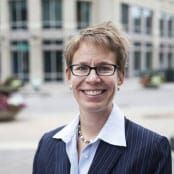Opportunity knocks: Opportunity zones unlock capital gains while investing in distressed communities
A BizWest Special Report

Imagine a concept supported by U.S. Sens. Michael Bennet (D-Colo.) and Tim Scott (R-S.C.), by Sen. Cory Gardner (R-Colo.) and Sen. Cory Booker (D-N.J.), by Sen. Kirsten Gillibrand (D-N.Y.) and Sen. Joni Ernst (R-Iowa). Given the partisan rancor that defines so much of the dialogue in Washington, such a bill sounds like a pipedream. But what if it wasn’t?
__________________________________
See related stories in this Special Report
Uncertainty produces hesitation among investors
SPONSORED CONTENT
The many benefits of simple, coordinated healthcare
Kaiser Permanente combines health care and coverage in one connected system to maximize employee health and minimize employer costs.
Finding funds takes wizardry in land of OZ
Boulder’s opportunity-zone speedbump
Map of Opportunity Zones in Northern Colorado
__________________________________
Nestled within the Tax Cuts and Jobs Act of 2017 was a little piece of bipartisan legislation called the Investing in Opportunity Act. The act established the framework for a new program — opportunity zones — aimed at updating the nation’s tax code to unlock the reinvestment potential of capital gains and direct that capital to the communities that need it most.
The zones are “designed to spur economic development by providing tax benefits to investors,” according to U.S. Internal Revenue Service guidelines.
While the mechanics of opportunity-fund investing can be complicated and still quite fuzzy from a regulatory perspective, the nuts and bolts of the program are straightforward.
Local governments selected economically distressed census tracts — those with populations with poverty rates of 20 percent or higher or median family incomes that did not exceed 80 percent of the metropolitan-area median family income — and applied for opportunity zone nomination. Those nominations were reviewed by the federal government, and opportunity zones were designated and certified by the secretary of the U.S. Treasury.
In the Boulder Valley and Northern Colorado, there are qualified opportunity zones in census tracts that include portions of Boulder, Dacono, Estes Park, Evans, Fort Collins, Greeley, Lafayette, Longmont, Louisville, Loveland and Superior.
Compared with other states, Colorado lands in the middle of the pack in terms of density of opportunity zones. Of the 1,249 census tracts in the state, 126 tracts, about 10 percent, are designated opportunity zones.
Hawaii has the lowest percentage of tracts designated opportunity zones at about 7 percent, and Wyoming has the highest at nearly 19 percent.
As far as other Colorado neighbors are concerned, Kansas has 9.6 percent of its census tracts designated, Nebraska has 8.3 percent, Utah has 7.8 percent, Arizona has 11 percent, Oklahoma has 11.2 percent, New Mexico has 12.6 percent.
Which specific government entity is in charge of administering opportunity-zone programs varies from state to state. In Colorado, the program is overseen by the Colorado Office of Economic Development and International Trade.

That office has a new department, led by Opportunity Zone Program Director Jana Persky, dedicated to cultivating investment in the zones.
“Colorado has earned national recognition for our thoughtful and inclusive approach designating opportunity zones, and we are committed to ensuring that we realize the maximum potential,” Gov. Jared Polis said in a February statement announcing the formation of the state’s opportunity zone office. “It’s vital that we continue to build on this momentum and collaborate with communities and investors to make these opportunities a reality to create good jobs.”
The state’s opportunity-zone program is funded through an Economic Development Commission allocation.
Once an opportunity zone is designated, a qualified opportunity fund must be established to serve as the investment vehicle.
Earlier this year, the Colorado Office of Economic Development and International Trade joined with Blackstone Entrepreneurs Network and Startup Colorado to launch Co-invest.co, an online platform to help investors match with companies and projects within opportunity zones.
“The Co-Invest platform will connect emerging and scaling companies with a whole host of capital sources from investors across the state and beyond,” Blackstone Entrepreneurs Network CEO Greg Greenwood said in a prepared statement. “After continually hearing about the fundraising challenges from companies across the state, we envisioned having a valuable online community asset to fill this capital-gap and are thrilled to see our collective vision realized.”
__________________________________
More information
https://choosecolorado.com/opportunity-zones/
Will Opportunity Zones help distressed residents or be a tax cut for gentrification?, from the Brookings Institute
The State of Opportunity Zones, from the Economic Innovation group
Opportunity Zone Funds: Investors Waiting in the Wings, from Prequin
Boulder Macy’s could be redeveloped into office space, from BizWest
__________________________________
Opportunity zones provide several key tax benefits. Investors are able to defer tax on any prior gains invested in an opportunity fund until Dec. 31, 2026, or until that investment is sold. For investments held for five years, taxes are excluded from 10 percent of that deferred gain. If the investment is held for seven years, that exclusion jumps to 15 percent.
After 10 years, the “investor is eligible for an increase in basis of the (opportunity fund) investment equal to its fair market value on the date that the (opportunity fund) investment is sold or exchanged,” according to IRS guidelines.
Simply put, the opportunity-zone program “helps provide a tool to bridge the gap that exists with more conventional funding mechanisms,” Estes Park Economic Development Corp. president Jon Nicholas said.
While opportunity zone investors are able to participate in a number of different types of development projects, economic-development leaders point to residential housing as a key focus area. This is particularly important in areas such as the Boulder Valley and Northern Colorado, where housing affordability has become a growing concern.

“To see resources become available in an economic time when we can certainly benefit from additional housing investment,” Boulder Chamber of Commerce President John Tayer said, “that’s the kind of thing where we saw the opportunity zone as a great advantage for our community.”
The opportunity-zone model is by no means the first place-based program aimed at revitalizing economically underserved neighborhoods, nor it is the first program to facilitate the reinvestment of capital gains.
In 1993, Congress enacted legislation to form the Empowerment Zone Program. Unlike the opportunity zone program, this program was not exclusively about providing tax incentives for investment.
Empowerment zones “focused on people and local services not just capital investments,” according to a Brookings Institute report. “They encouraged hiring, subsidized upfront investment in capital and equipment, offered loan guarantees, regulatory waivers, a partial exclusion of capital gains, and large grants to local government authorities for local services and infrastructure.”
Opportunity zones are also not the first or only program designed to incentivize reinvestment of capital gains.
Investors may already be familiar with 1031 exchanges, a mechanism that allows investors to defer taxes on capital gains from real estate investments by rolling those gains into a new real estate investment. While this kind of exchange shares certain attributes with the opportunity zone program, the two are distinct.

“We have been getting more and more questions every week, and as the months go by about opportunity zones, what are they, and how they can work with a 1031 exchange,” Julie Baird, vice president and western regional manager for First American Exchange Co., said during a panel on opportunity zones during BizWest’s recent Northern Colorado Real Estate Summit.
One of the main differences between opportunity-zone investments and 1031 exchanges, Baird said, is the fact that opportunity zones involve “a community aspect … a bigger community feel to it.” The goal of the program is slightly loftier than simply providing incentives to reinvest gains.
“The goals of the 1031 exchange are much more isolated … and individualized for the individual taxpayer,” she said.
It some ways, 1031 exchange investments are more flexible because investors are not restricted in terms of geography, Baird said. Opportunity-fund investments must occur within opportunity zones; 1031 exchanges have no such restriction.
For opportunity funds, only capital gains must be invested to realize the full tax benefits. The 1031 exchange requires the total value of the asset to be rolled over into a new investment.
“If the [1031] investment was $1 million, you’d have to go and buy a $1 million replacement asset to get a 100 percent tax deferral,” Baird said. “That’s a big difference.”
Rules dictating whether tax deferral benefits from opportunity-fund investments and 1031 exchanges can be combined remain murky. Investors are also clamoring for clarity and regulatory guidance on a host of other issues related to opportunity zones.
“There’s a lot of uncertainty around how the tool is going to work,” Baird said.
Opportunity zones — where are they?
Opportunity zones in the Boulder Valley and Northern Colorado include 11 areas that range from a distressed shopping center in Boulder to an area north of the University of Northern Colorado in Greeley. Here’s a rundown of designated zones in the region:
Boulder
Boulder’s opportunity zone is 2.5-square-mile tract stretching from 28th to 55th streets and Arapahoe Avenue to the Diagonal Highway. The zone includes dense residential neighborhoods, including several mobile home communities, commercial and office spaces, mixed-use developments such as Boulder Junction, as well as the nearly vacant Diagonal Plaza shopping center.
Boulder’s opportunity zone Includes roughly 7,000 residents. The median household income for the area is about $54,000.
Dacono
The opportunity zone in the Dacono area of Weld County makes up a roughly 4-square-mile zone just east of Interstate 25 and Colorado Highway 52.
The tract includes residential neighborhoods off Flying Circle Boulevard and Glen Creighton Drive, the city’s older mixed-use district around Dacono City Hall and commercial corridor along Highway 52.
There are about 4,400 people who live in the census tract and the median household income is more than $51,000.
Estes Park
Estes Park has a very large opportunity zone that encompasses a roughly 42-square-mile tract bordered by the Boulder County line to the south and U.S. Highway 36 to the north. It is bisected by St. Vrain Avenue.
The area includes residential neighborhoods south of Prospect Avenue, municipal and school operations west of Fish Creek Road, multifamily housing communities along St. Vrain Avenue and the Estes Park golf course.
Evans
The opportunity zone in Evans encompasses less than two-square-miles and is bordered by the South Platte River to the south and U.S. Highway 34 to the north. U.S. Highway 85 bisects the zone, which is home to about 4,400 residents. The median income is about $42,000.
Evan’s zone is home to a small residential area and large swaths of industrial sites. Along the U.S. Highway 85 corridor are a host of underutilized lots, motels and storage facilities.
Fort Collins
Fort Collins has two neighboring census tracts that are designated opportunity zones, both just east of College Avenue. The northern tract is bordered by Vine Drive to the south, the Pheasant Ridge neighborhood to the north and Lemay Avenue to the east. The tract just south of it stretches south to Mulberry Street and east to Interstate 25.
The combined tracts include about five square miles with a population of about 5,000. The median household income is about $53,000 in the northern tract and about $43,400 in the southern.
The western portions of the zones are mainly undeveloped agricultural properties. The eastern portions include the edges of Old Town’s commercial and residential areas and businesses such as New Belgium Brewing Co. and Odell Brewing Co. The northern portion of the zones include industrial districts west of College Avenue and residential neighborhoods such as Greenbriar and Evergreen.
Greeley
Greeley’s opportunity zone is situated just north of the University of Northern Colorado.
It is less than a square mile and is home to about 2,600 residents. The median income is about $21,500.
The western portion of the tract north of the intersection of 16th Street and 11th Avenue is mostly residential, while the corridor along Eighth Avenue is heavily commercial. The western portion of the zone includes industrial properties adjacent to railway tracks.
Longmont
Longmont has two opportunity zones directly adjacent to one another. Together, they encompass much of the southern portion of the city, stretching from Ninth Avenue to just north of Ken Pratt Boulevard and from Hover Street to Lashley Street.
The combined tracts encompass about 2.5 square miles and have a combined population of about 9,000 people. The median household income of the western tract is about $69,000, while the median in the eastern tract is only about $39,000.
The Longmont zones are home to a wide variety of commercial and residential areas. The areas include historic neighborhoods, bars and restaurants in the downtown area around Main Street, industrial districts along St. Vrain Creek and newer retail centers such as Village at the Peaks.
Louisville/Lafayette/Superior
The opportunity zone in eastern Boulder County that includes portions of Louisville, Lafayette and Superior is about eight square miles. It is bordered on the southwest by U.S. Highway 36 and on the north by Baseline Road. It is bisected by Northwest Parkway.
The zone is home to about 7,000 people, and the median household income is about $50,000.
While the tract is relatively undeveloped compared with surrounding areas, the zone includes residential areas near Good Samaritan Medical Center and neighborhoods west of the intersection of South Public Road and East Boulder Road.
Loveland
Loveland’s nearly two-square-mile opportunity zone is located in the southern portion of the city and is bordered by U.S. Highway 287 to the east, Taft Avenue to the west, Eighth Street to the north and 14th Street to the south.
The zone is home to about 3,300 residents, and the median household income is nearly $48,000.
Loveland’s tract includes industrial operations north of 14th Street, natural areas and ponds east of Taft Avenue, residential neighborhoods south of Lake Loveland and the commercial corridor along Lincoln Avenue.
Imagine a concept supported by U.S. Sens. Michael Bennet (D-Colo.) and Tim Scott (R-S.C.), by Sen. Cory Gardner (R-Colo.) and Sen. Cory Booker (D-N.J.), by Sen. Kirsten Gillibrand (D-N.Y.) and Sen. Joni Ernst (R-Iowa). Given the partisan rancor that defines so much of the dialogue in Washington, such a bill sounds like a pipedream. But what if it wasn’t?
__________________________________
See related stories in this Special Report
Uncertainty produces hesitation among investors
Finding funds takes wizardry in land of OZ
Boulder’s opportunity-zone speedbump
Map of Opportunity Zones in Northern Colorado
__________________________________
Nestled within the Tax Cuts and Jobs Act of…
THIS ARTICLE IS FOR SUBSCRIBERS ONLY
Continue reading for less than $3 per week!
Get a month of award-winning local business news, trends and insights
Access award-winning content today!


